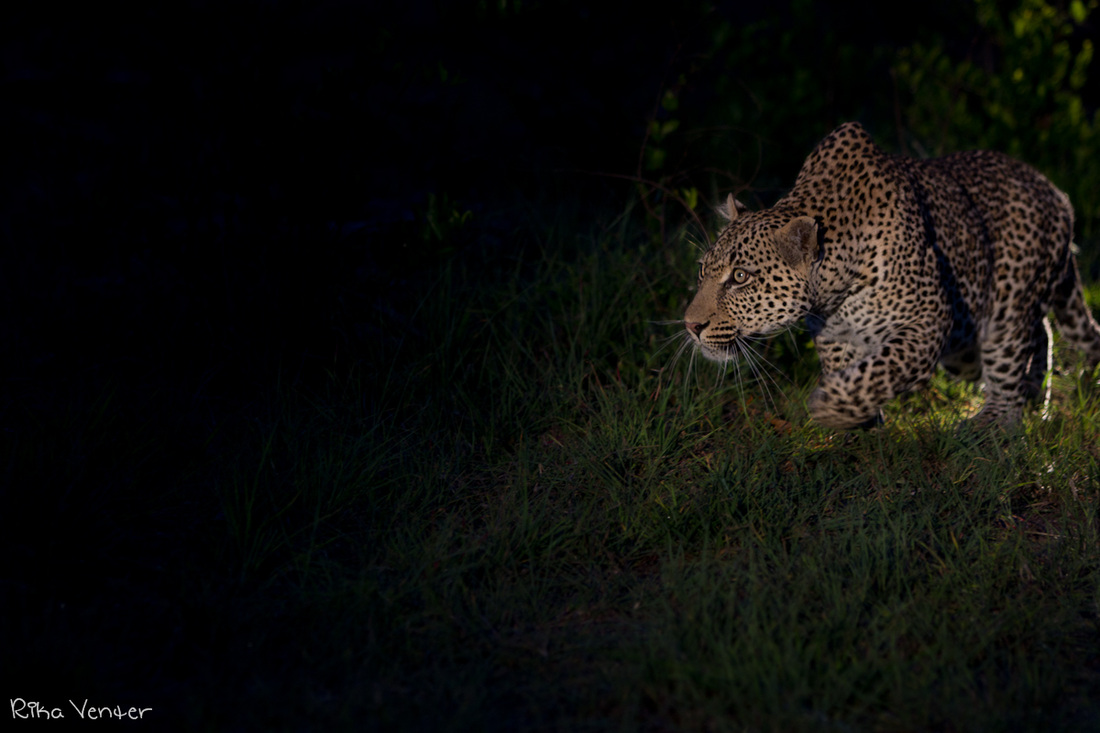|
Whiskers are the sensory appendages that leopards, and all felines, use to interpret the world around them. The scientific name for a whisker is ‘vibrissae’ and comes from the Latin, ‘vibrio’ meaning vibration. They are used for a variety of functions but most commonly as spacial sensing device. It is no coincidence that the diameter of a leopard’s whiskers is wider than the width of the body. This therefore allows them to gauge the distance between objects and make a judgment of whether they can pass through. Whiskers are present in a variety of places on a leopard’s body, but most noticeable are the macro vibrissae which are situated on the sides of the muzzle. They are noticeably longer than the other hairs enveloping the body and are made of a sturdier keratin. These vibrissae are not randomly positioned either. If you look closely, you will see that the hairs are shorter in the front and longer at the back, thus allowing for an ordered grid of arcs to interpret its surroundings. The whiskers are set into a special hair follicle that contains a tiny capsule of blood, known as a blood sinus. When the whisker is caused to move by an external stimulus, the blood in the sinus is pushed one way or the other. The blood helps to amplify the movement and allows the nerve ending to detect extremely small sensations. Each whisker can have as many as 200 individual nerve cells which will then pass on this information to even more numerous nerve receptors deeper within the cat’s body. A leopard will have approximately 30 whiskers on each side of its face and thus have access to over 30,000 nerve receptors! To put this in perspective, our fingertips have about 2500 receptors per cm2. The whiskers are so sensitive that they can even sense vibrations in the changing air currents and can therefore add another dimension to the way in which they perceive the world. Leopards are masters of sensory detection. In fact, their whiskers are the longest of any of the felines, in relation to their size. Their nocturnal tendencies and dense habitat preference have caused them to evolve to be masters of their domain. Negotiating through thick riverine vegetation in the dead of night would prove extremely troublesome if the leopard was not able to gauge the size of an opening. This is also important in stalking prey as it allows the leopard to brush against less vegetation and thus make less noise, enabling it to approach close by before pouncing. The whiskers’ position next to the mouth also allows the leopard to judge exactly where to deliver the killing blow. It is hard to see exactly where your mouth is, so the whiskers act as a guide in the same way that birds have rictal bristles to facilitate prey capture. The highly specialized and sensitive vibrissae are just one of many adaptations that had enabled the leopard to become the world’s most widely distributed wild cat Text by Ben Coley
Photos by Ben Coley and Rika Venter
5 Comments
14/4/2014 05:53:23 am
Thank you for the wonderful articles that you place here on your blog. I do enjoy all the info so much.
Reply
deadpool
21/4/2016 12:05:07 pm
cool
Reply
26/10/2016 07:01:31 pm
Authors had given a good anatomical information on whiskers.
Reply
26/7/2017 12:21:21 pm
I am carving a life-sized jaguar and need to know the diameter of whiskers. Hard to find data! Also, are the whiskers tapered at the ends? Hard to see in pictures.
Reply
Alexe
11/1/2023 12:47:52 am
Thank you for good information about function of whiskers,
Reply
Leave a Reply. |
Authors:Leopard statuses and happenings by Leopard ID Project team leaders. Archives
October 2014
Categories |




 RSS Feed
RSS Feed
